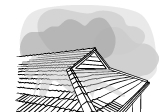
A roof’s job, in the simplest terms, is to keep the elements out. If a roof isn’t weatherproof, it can cause major structural damage the entire house, and everything it contains.

It might seem blindingly obvious, but it has to be said: excluding weather elements like rain, sun, snow, wind and dust from the interior of a home is the primary function of a roof. Without a tightly constructed and fitted roof, your house would be exposed to extremes of heat and cold, and you wouldn’t be able to protect your furnishings or possessions from the damp.
Prolonged exposure of interiors to even small amounts of leakage will encourage mould to grow, and this in turn may lead to respiratory illness and other serious health issues. Likewise, if the roof isn’t able to keep the rain out properly, it’s also likely to lead to structural damage in the form of rot.
How to weatherproof your roof
A big part of weatherproofing a roof is ensuring that the cladding material you use and the shape of the roof are appropriate to your local climate. For example, terracotta or wooden shingles are not recommended for climates which experience strong driving winds and rain. Driving wind and rain can force moisture in between the shingles and then inside the house. Take advice from local builders or architects as to what shapes and materials work best with the types of weather your house is likely to experience.
Sarking – a layer of reflective foil laminate which also acts as a vapour barrier – is also required by the building code in some situations where the wind and the angle of your roof make it likely that water will accumulate and penetrate between tiles (according to Australian Standard AS 2050 – Installation of roof tiles). Sarking isn’t always required or may only be required for parts of the roof, but it’s never a bad idea – sarking is an effective weatherproofing measure and a good way to safeguard against damage from failed roofing or extreme weather.
How is weatherproofing affected by penetration and flashing?
Penetrations are the necessary openings made in a roof for vents, pipes and air conditioning units. Over time, the seals around roof penetrations and flashing can degrade. Without maintenance, these seals can become less watertight, allowing moisture into your roof. Roofs should be examined at least once or twice per year to ensure they remain watertight. Your roof penetrations should also be checked after particularly heavy storms or cyclones.
Weatherproofing for extreme conditions
If you’re building in an area that’s prone to either bushfire or cyclones, you need to investigate which kinds of roofing materials and styles are suitable for these weather conditions. The roofs you build in these areas will need to comply with the relevant bushfire or cyclone codes.
For houses in alpine regions, you will also need to take into account the extra load bearing requirements that snowfalls may place upon a roof. Likewise, steel roofs will need to be specially treated to ensure that they’re suitable for use near the ocean, to prevent corrosion.
Popular roofing materials and weatherproofing
Below is a basic comparison of the different weatherproofing properties of common roofing materials:
Metal
- low thermal mass, does not store solar energy – good for warm climates
- safe in strong winds if the roof is installed and maintained properly
- suitable for alpine regions – smooth finish encourages snow to slide off
- good protection against rain and moisture, with a risk of corrosion after long periods
- suitable for bushfire zones
- may suffer from dents or damage during hail
Concrete tiles
- high thermal mass, excellent in climates that experience warm days and cold nights
- resists breakage from flying debris in strong winds
- may crack in in extreme cold
- water resistant in all but the most driving rains
- non combustible – safe for bushfire regions
Terracotta tiles
- good thermal mass – slow to transmit heat indoors
- not recommended for extremely windy zones as debris can crack tiles
- weight of snowfall may cause cracking in tiles
- water resistant in all but the most driving rains
- non combustible – safe for bushfire regions





